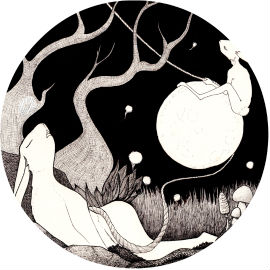Little Miss Muffet
Sat on a tuffet
Eating her curds and whey;
Along came a spider,
Who sat down beside her,
And frightened Miss Muffet away.
The first printed version of ‘Little Miss Muffet’ appeared in a book of nursery rhymes published in 1805, though one old rumour has it that the Elizabethan naturalist and physician, Doctor Thomas Muffet, penned the verse for his daughter, Patience.
It makes a nice story, since Dr Muffet was something of an entomologist. His most famous publication was an illustrated work called Insectorum sive Minimorum Animalium Theatrum (or the Theatre of Insects). It included lots of quite spectacularly lovely and alarming portraits of various arachnids.
Dr Muffet was quite enamoured of spiders, writing affectionately about the elegant ‘tapestry and hangings’ with which they adorned his half-timbered home. He also wrote that a spider’s:
skin is so soft, so smooth, polished and neat, that she precedes the softest skin’d Mayds, and the daintiest and most beautiful Strumpets … she hath fingers that the most gallant Virgins desire to have theirs like them, long, slender, round, of exact feeling, that there is no man, nor any creature, that can compare with her.
Doctor Muffet also believed that the venerable and sensuous spider was the source of a cure for almost anything. Among other things, he advised stuffing a dead house spider in a nutshell or leather pouch hung around the neck to ward off fevers; boiling three live spiders in oil to use as ear drops; and, most efficaciously, to treat almost anything, mashing spiders in a bowl and eating them with a spoon.
Thank goodness Miss Muffet was only eating curds and whey!
Curds and whey are produced when you curdle milk. The curd is the whitish lumps that are produced, and the whey the liquid. These days, most of us eat one form of curd product or another. Cottage cheese, curd cheese or queso blanco anyone?
Doctor Moffet, by the way, recommended the consumption of soft, curd cheeses in his other famous book, Health’s Improvement; or Rules Comprizing and Discovering Nature, Method and Manner of Preparing All Sorts of Food Consumed in This Nation (published in London in 1655), in which he wrote that the eating of hard cheese, especially by ‘non-labouring men’ had various unsavoury results, including that it:
stoppeth the Liver, engendereth cholera, melancholy, and the stone, lieth long in the stomach, undigested, procureth thirst, maketh a stinking breath and a scurvy skin.
When Boo and I were in Madison, Wisconsin last year, we discovered the heavenly guilty delight that is deep-fried cheese curds. Oh my!
But today I thought we might make a different kind of curd – lemon curd – used for topping cheesecakes, spreading on warm muffins with butter, or (in a forthcoming post) filling raspberry & lemon curd madeleines.
Ingredients
- 3 lemons
- 220 grams of caster sugar
- 110 grams of unsalted butter
- 3 eggs (lightly beaten)
Method
- Wash and dry one of the lemons, and finely grate its zest.
- Place the zest, sugar and butter in a saucepan over VERY LOW heat. Stir with a wooden spoon until the sugar has dissolved.
- Squeeze all three lemons and strain the juice.
- Add the lemon juice and the beaten eggs to the saucepan, whisking briskly.
- Continue to stir the curd over a low heat. Don’t be tempted to turn up the heat. Think of your curd as one of those lovers who needs a gentle, slow hand (and doesn’t want you to ‘come and go in a heated rush’!) Stir the curd constantly and patiently, allowing the mixture to thicken up enough to coat the back of your spoon. You’ll also notice that the white film on top of the curd dissolves into the golden yellow liquid when it’s ready.
- Cool the curd slightly before storing in a jam jar with a screw-top lid, then allow to cool completely before refrigerating.
- You can keep your curd in the refrigerator for about a month. If it lasts that long without being gobbled up!
Some other options
You can make the same sweet curd with almost any citrus fruit. Lime or orange are delicious!
To make passionfruit curd substitute 10 passionfruit for the three lemons in the recipe above. Strain eight of the passionfruit to reduce the amount of pulp, using only two unstrained passionfruit.
Let us know how you go making your own lemon curd! (Or curds and whey for that matter).



No Comments